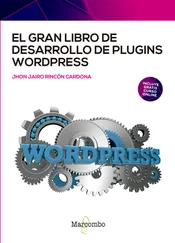NOTE Menus are a common feature in WordPress plugins and are generally expected by users. It's a good idea to mention where your plugin settings can be found in the plugin description and documentation.
Now that you have a new top‐level menu created, create some submenus for it, which are menu items listed below your top‐level menu. For example, Settings is a top‐level menu, whereas General, listed below Settings, is a submenu of the Settings menu. To register a submenu, use the add_submenu_page()function.
The add_submenu_page()function accepts the following parameters:
parent_slug: Slug name for the parent menu ( menu_slug previously defined)
page_title: Title of the page as shown in the
menu_title: Name of your submenu displayed on the Dashboard
capability: Minimum capability required to view the submenu
menu_slug: Slug name to refer to the submenu; should be a unique name
function: Function to be called to display the page content for the item
Now that you know how submenus are defined, you can add one to your custom top‐level menu.
The preceding code creates three submenus for your custom top‐level menu: About, Help, and Uninstall, as shown in Figure 3‐2. Each of these submenu items links to a different custom function that can contain any code you want to use for that submenu page.

FIGURE 3‐2 : Submenus
NOTE Not all plugins will need submenus. For example, a plugin with a single settings page has no need for additional submenus. When creating your new plugin, it's important to determine if submenus will be needed for a good user experience.
Adding a Menu Item to an Existing Menu
If your plugin requires only a single options page, you may not need to create a custom top‐level menu. Instead, you can simply add a submenu to an existing menu, such as the Settings menu.
WordPress features many different functions to add submenus to the existing default menus in WordPress. One of these functions is the add_options_page()function. Now explore how the add_options_page()function works to add a submenu item to the Settings menu.
The add_options_page()function accepts the following parameters:
page_title: Title of the page as shown in the
menu_title: Name of your submenu displayed on the Dashboard
capability: Minimum capability required to view the submenu
menu_slug: Slug name to refer to the submenu; should be a unique name
function: Function to be called to display the page content for the item
Now add a submenu item to the Settings menu.
The preceding code adds a submenu labeled PDEV Settings under the Settings menu, as shown in Figure 3‐3. Set the page title to PDEV Plugin Settings, set the capability to manage_optionsso that only administrators can view it, and set the function pdev_plugin_option_page()to be called when the submenu is clicked.

FIGURE 3‐3 : Submenu labeled PDEV Settings
The following is a list of all available submenu functions in WordPress:
add_dashboard_page: Adds a submenu to the Dashboard menu
add_posts_page: Adds a submenu to the Posts menu
add_media_page: Adds a submenu to the Media menu
add_links_page: Adds a submenu to the Links menu
add_pages_page: Adds a submenu to the Pages menu
add_comments_page: Adds a submenu to the Comments menu
add_theme_page: Adds a submenu to the Appearance menu
add_plugins_page: Adds a submenu to the Plugins menu
add_users_page: Adds a submenu to the Users menu
add_management_page: Adds a submenu to the Tools menu
add_options_page: Adds a submenu to the Settings menu
To use any of these functions, simply swap out the function name in the code shown earlier.
NOTE If your plugin requires only a single options page, it's best practice to add it as a submenu to an existing menu. If you require more than one, create a custom top‐level menu.
Now that you've learned how to create menus and submenus in the WordPress Dashboard, it's time to create a settings page for your plugin. WordPress enables easy access to the database to store and retrieve data, such as options end users can modify and save in settings pages or internal information plugins you need to know. You'll learn how to save and fetch this data using the Options API and internal WordPress functions.
The Options API is a set of functions that enable easy access to the database where WordPress, plugins, and themes save and fetch needed information.
Options are stored in a database table named, by default, wp_options and can be text, integers, arrays, or objects. For example, WordPress keeps in this table the title of your blog, the list of active plugins, the news articles displayed on the Dashboard, or the time to check if a new version is available.
You'll now learn how to use the functions to access, update, and save options: add_option(), update_option(), get_option(), and delete_option().
You start by saving your first plugin option, which will be named pdev_plugin_colorand have a value of red. The function call to do so is the following:
The add_option()function accepts the following parameters:
option: Name of the option to add
value: Value of the option you are adding
deprecated: Description, which is no longer used
autoload: Whether to load the option when WordPress starts
The first parameter is your option name. It is crucial that you make it unique and self‐explanatory.
Unique: It will never conflict with internal existing or future WordPress options or with settings that might be created by another plugin.
Self‐explanatory: Name it so that it's obvious it's a plugin setting and not something created by WordPress.
NOTE Using the same prefix, for example , pdev_plugin, for function names, options, and variables is highly recommended for code consistency and for preventing conflict with other plugins. The golden rule of “Prefix everything,” first introduced in Chapter 2, applies here.
The second parameter is the option value that can be practically anything a variable can hold: string, integer, float number, Boolean, object, or array.
Saving an Array of Options
Every option saved adds a new record in WordPress’ option table. You can simply store several options at once, in one array. This avoids cluttering the database and updates the values in a single MySQL query for greater efficiency and speed.
$options = array( 'color' => 'red', 'fontsize' => '120%', 'border' => '2px solid red' ); update_option( 'pdev_plugin_options', $options );
Saving your plugin options in one array rather than individual records can have a huge impact on WordPress’ loading time, especially if you save or update many options. Most of the time, PHP code executes fast, but SQL queries usually hinder performance, so save them whenever possible.
Читать дальше














